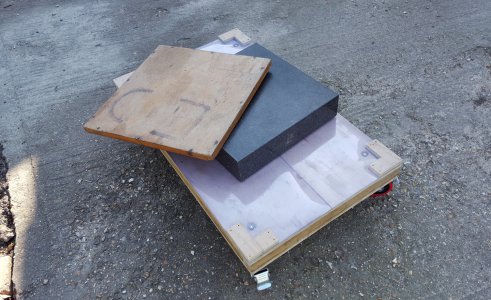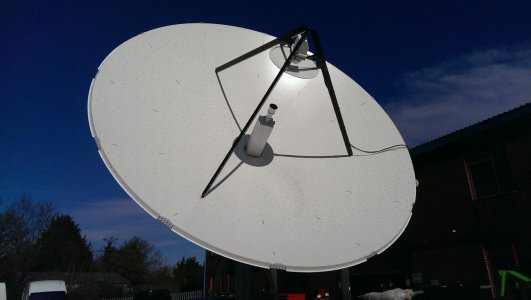- Joined
- May 27, 2016
- Messages
- 3,469
Wow! A real score! Would that be granite type?With load fee etc, I was able to acquire a 3'x4' surface plate for less than US $200. I'm sure I'll spend more than twice that having it calibrated. I think there is an aspect of intellectual pursuit to your method, rather than just purely pragmatic progress.
Mine was acquired as a freebie, because it had been replaced by a new, larger one, and it had stood around for a couple of years unused. My pals even delivered it for me

In the work I did at the time, I would have the surfaces of satellite Earth Station tracking dishes tested. The surface would be a optically shaped not-quite parabola polynomial in carbon fibre. It is quite difficult to get a 6.1m or 7.3 metre diameter Cassegrain dish, with its subreflector optics surfaces made and positioned all to within 0.25mm (0.0098 inch). The measure method was photogrammetry, where the surfaces are covered in accurately made little circular decals, and various bar-codes. Also, an invar bar covered in barcodes is placed in the dish. A camera on a pole is used to take a series of images that are then processed by the software, adjusted to get all the corresponding decals to register. The software is then capable of fitting the whole lot in comparison to a CAD model, and publishing coloured contour plots of deviations. One can see immediately where the departures are or where the cure in the mold had a distortion.

You can look up the technique, and I am sure there will be stuff on YouTube. This stuff is widely used in the aerospace industry, and the software is available. There are even free open source versions, and various ways of calibrating digital cameras. You can, of course, buy the whole kit, but it comes expensive. Applied to smaller stuff, like say a thing like a lathe bed, I just don't know the kind of accuracy it is capable of. I had a hard enough time getting the work to under 0.25mm (but the thing was huge)! The measure kit seemed accurate to better than 0.1mm (0.004"), even on that scale. The servo kit behind has resolution to point to within about 300 milli arc-seconds. It has to find a moving target satellite position accurately, but also at an exact celestial time.
The clinometers are set up on a granite surface plate, but that is only good enough for an approximate start point. They are then set to track a sunspot, to discover construction leveling correction and North axis. Finally, known satellites are tracked, and the numbers adjusted to achieve true horizon and zenith calibration.
From what I learned among the guys who do this, I do suspect that traditional scraping just might be augmented by some newer tools, and different technology techniques. Now away from the rat-race, I am quite happy to scrape away on my own stuff, with some reference to Connelly, but not exclusively, when I want to try something of my own.
Last edited:

